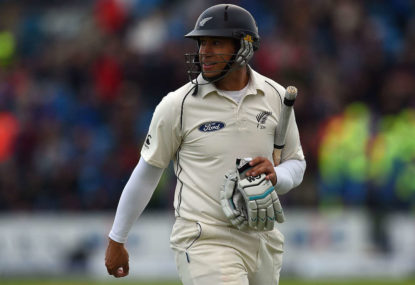WATCH: Freddy Flintoff's son dominates County 2nds game batting exactly like his dad
Check out some of the short-arm pull shots from Rocky Flintoff!

The second Test between Australia and New Zealand ended in a draw, just as the gods and/or WACA curator intended.
Here are the ratings for the last two days of the Test.
Ross Taylor’s Records
Grade: B+
Going into the fourth day of the Test, New Zealand were 6/510, trailing Australia by just 49 runs, with Ross Taylor 235 not out.
The plan from there was simple. Bat all day, allowing Taylor the opportunity to beat Brian Lara’s record score of 400. Then have Trent Boult stunningly break whatever record Taylor had set. Declare and bowl Australia out on the fifth and final day.
This plan was proceeding perfectly for Brendon McCullum, right up until the point that Ross Taylor was well caught off the bowling of Lyon for a mere 290, which virtually all of the cricket statisticians at the ground agreed was ‘at least 80′ short of the record.
Cricket statisticians: not as obsessed with precision as you might think.
Regardless, Taylor’s 290 was sufficient to break all manner of other records, including the highest score by a visiting batsman in Australia, the highest score by a New Zealand batsman against Australia, the first ever score of 290 in Test cricket, and the highest score ever made against a team containing three Mitchells.
Substitute Fielders
Grade: D
The catch to dismiss Taylor was taken by the substitute fielder Jonathan Wells, so in addition to being a well-taken catch, it was also a Wells-taken catch.
It’s been quite a few days for young Wells. Earlier in the Test, he had the thrill of being glared at by Steve Smith when he failed to pick up a shot off Smith’s bowling, running the wrong way as it flew to the boundary. A great moment for the lad which he’ll remember forever.
But as useful as substitute fielders are for basic wordplay and captain-frustrating, should they really be permitted to be part of the game? The ICC saw fit to remove runners from cricket, tragically denying us one of the greatest sources of comedy the sport had to offer. Wouldn’t it make sense to partially redress the balance by removing all forms of player substitution?
After all, what would be funnier than forcing Smith to find a place to hide the hobbled Usman Khawaja in the field, while Taylor went the tonk? Admittedly, that’s a poor example, since it’s not a lot different from what Smith was doing before Khawaja was injured. But the general principle applies.
Having injured players on the field would be amusing, and, should a player be too injured to even take his place on the field, then that would just create more gaps, and hence, higher scores. And if there’s one thing this Test has taught us, it’s that batsmen scoring loads and loads of effortless runs never gets boring.
Shaking Hands
Grade: C
After Taylor’s dismissal, not one Australian player shook his hand. This caused much consternation, most notably from ABC commentator Dirk ‘The Irked’ Nannes, who called it ‘horrendous sportsmanship’.
Perhaps, but having surrendered a first innings lead, could the Australians run the risk of an adrenaline-charged Taylor breaking the bones in all their hands with his brutish grip?
Of course not. Sensible caution shown from Smith and his teammates.
Doing Teams Favours
Grade: C
After a couple of early wickets, Smith and Adam Voges then guided the Australians to a 193-run lead at the end of Day Four, via a pair of centuries.
Smith had moved back to three and Voges to four to cover for Khawaja. This was a blatant attempt from Smith to convince the selectors that the new free batting slot for Adelaide should be number five, opening the door for a Glenn Maxwell recall.
Alas, this order-shuffling ploy didn’t work, with the selectors, in their infinite wisdom, instead deciding to finally give Shaun Marsh a much-deserved chance in the team.
The question, then, was when Australia would declare on the final day. Word came out that Smith planned to do New Zealand no favours. And he was good to his word, setting New Zealand 321 runs in only 48 overs, a target they never seriously chased as the match petered out to a draw.
Australia shockingly abandoning their traditional policy of doing the opposition favours. Truly a new era.
Still, Australia lead the declaration count in this series 4-0, and isn’t that the most important thing?
Mitchell Johnson’s Retirement
Grade: A
Of course, most of the action on the final day was overshadowed by the news that Mitchell Johnson was retiring from all international cricket.
Needless to say, those fans who ridiculed Graeme Swann for retiring halfway through a series in the 2013-14 Ashes all emerged to similarly condemn Johnson for his mid-series retirement.
Ha ha ha. No, of course they didn’t. Marvellous, really, how much we’ve all grown over the last two years and now accept that people should have the right to retire from their sport whenever the hell they like.
Fittingly, once the game was over, Johnson was chaired from the field by Starc and Hazlewood, a bowler to his left butt cheek, a bowler to his right.
That Mitchell Johnson, he did all right.